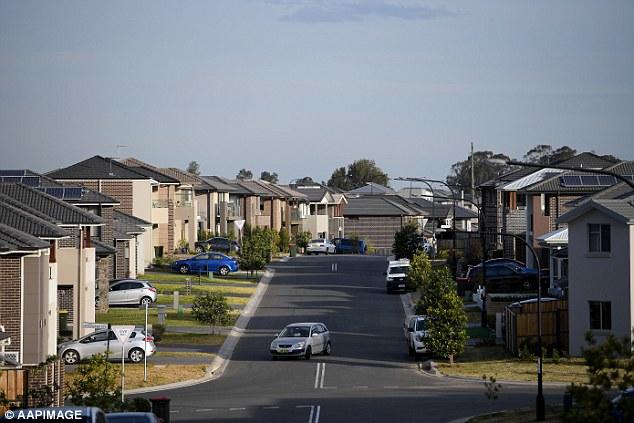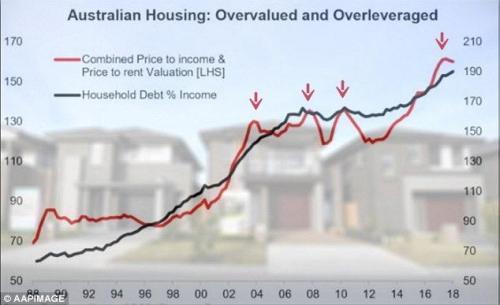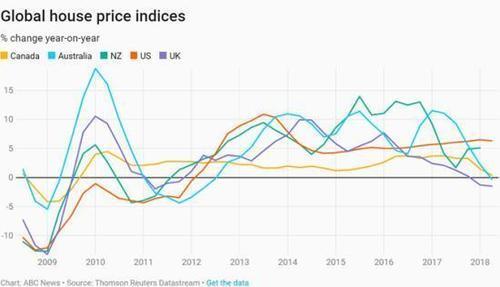Six weeks after we noted that Australian housing regulators were warned to prepare “contingency plans for a severe collapse in the housing market” that could lead to a “crisis situation,” CoreLogic reports that Melbourne housing prices have fallen at their fastest quarterly pace on record, according to Australia’s News.com.au.
CoreLogic figures released on Friday show national dwelling values declined another 1 per cent in January, bringing the cumulative decline to 6.1 per cent since the overall market peaked in October 2017. –News.com.au
Prices in Sydney and Melbourne fell 1.3% and 1.6% respectively in January, “bringing their rolling quarterly falls to 4.5 per cent and 4 per cent,” according to the report.
From their respective peaks in July and November 2017, Sydney housing prices are down 12.3% , while Melbourne has seen a drop of 8.7% – as values drop to levels last seen between late 2016 and early 2017.
“If you had asked me in September last year I probably would have been surprised to see Sydney and Melbourne values down more than 4 per cent over the rolling quarter,” said Tim Lawless, head of research at CoreLogic.
“We have seen the downturn accelerate over the last three months. At 4 per cent down in Melbourne that’s the fastest rate of decline we’ve ever seen of any rolling three-month period, and Sydney is virtually (the fastest outside) a really brief period in the ‘80s.”
The decline in Sydney is now the worst since CoreLogic began collecting records in 1980 – surpassing the previous record of 9.6 perdcent seen between 1989 and 1991. Melbourne experienced a drop of 10% over the same period.
“Sydney clearly is in new territory,” said Lawless. “I think we can firmly point towards tighter credit and lending conditions throwing a dampener over the market.”
That said, given the relatively robust economic conditions, Lawless considers the drop to in Sydney and Melbourne be a “consolidation,” while also forecasting total declines in the two cities of 18% – 20% (after prices rose nearly 80% and 60% respectively).
Unlike previous downturns, which typically coincide with a sharp rise in mortgage rates, this downturn is occurring against a backdrop of reasonably robust economic conditions, decent jobs growth and low rates.
“If anything it’s a consolation,” Mr Lawless said. “The RBA can bring rates down, there’s a potential that might happen, people have jobs and are able to pay down their mortgages. In that sense the downturn is manageable.”
He conceded that “we are seeing some wealth destruction”. CoreLogic now forecasts total declines in Sydney and Melbourne of 18-20 per cent, but notes that comes after prices rose nearly 80 per cent and 60 per cent respectively. –News.com.au
“Most homeowners would still have a great deal of equity in their properties,” said Lawless. “It’s really just those owners that have bought in the last couple of years that are facing the prospect of negative equity.”
More pain in the cards
While Lawless has characterized the drop as a consolidation, others foresee continued difficulty in the Australian housing market.
AMP Capital chief economist Dr. Shane Oliver predicted an average peak-to-trough price drop of 10-15%, while revising his forecast for Sydney and Melbourne down from a drop of 20% to 25%.
“A crash landing — say a national average price fall in excess of 20 per cent — remains unlikely in the absence of much higher interest rates or unemployment, but it’s a significant risk given the difficulty in gauging how severe the tightening in bank lending standards in the face of the royal commission will get and how investors will respond as their capital growth expectations collapse at a time when net rental yields are around 1-2 per cent.”
One analyst has even tipped falls of up to 30 per cent, based on the revelation from the banking royal commission that almost all mortgages written between 2012 and 2016 had used the controversial HEM benchmark to over-assess borrowing capacity.
Douglas Orr from Endeavour Equity Strategy said his scenario, in which the focus on responsible lending in the wake of the royal commission’s final report leads to billions of dollars in unaffordable loans gradually cycling out of the system, would make it the worst downturn since 1890. –News.com.au
At the end of January, the median home value in Sydney was $795,509, and $636,048 in Melbourne. Every capital city experienced declines aside from Canberra, which saw values gain 0.2%.
Leading the declines were the most expensive end of the market.
Meanwhile, Australia’s debt-to-income ratio has ballooned to shocking levels over the past three decades as Sydney is ranked as one of the most overvalued cities in the world.
According to the Daily Mail Australia last August, credit card bills, home mortgages, and personal loans now account for 189 percent of an average Australian household income, compared with just 60 percent in 1988, as Callus Thomas, Head of Research of Topdown Charts, demonstrates that record high household debt is a ticking time bomb.
For more on Australian debt dynamics, watch the video below from economists John Adams and Martin North:
via ZeroHedge News http://bit.ly/2D1j62l Tyler Durden


